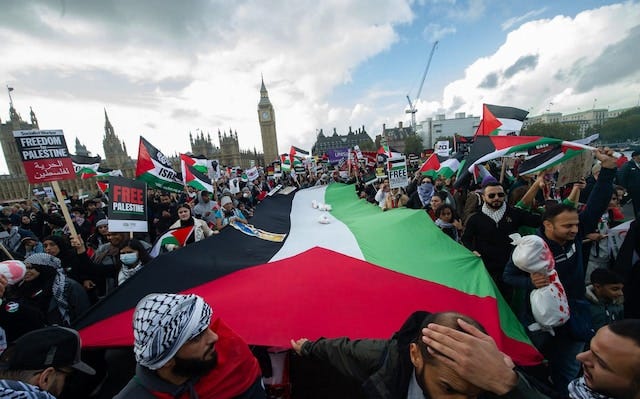By Mansour
"This essay is not concerned with what the Muslim Brotherhood once was. Its founding in 1928, its ideological blueprint, and its oscillating fortunes in the Arab world have already been exhaustively narrated. Rather, I intend to draw attention to what the Brotherhood has become; not in Cairo or Khartoum, but in Washington, London, Toronto, and Brussels. Specifically, I want to examine how it has been reconstituted within Western liberal democracies: tactically, institutionally, and discursively. The Brotherhood’s wager, and its remarkable success, has been to mutate from a revolutionary political movement into a civil rights formation—not an ideology to be confronted, but an identity to be recognized.
This transformation is not incidental. It is the product of a slow, deliberate, and adaptive strategy; one that learned to navigate the symbolic economy of liberal societies by internalizing their most potent currency: moral vulnerability.
No longer presenting itself as a transnational Islamic project seeking to reorder the world in accordance with divine sovereignty, at least not in the West, the Brotherhood now postures as a culturally marked subject of systemic injustice. It appears less as an agent of historical ambition than as a post-colonial casualty of racialization and exclusion. Its political theology has been partially sublimated into a politics of grievance, thereby gaining access to the institutional, symbolic, and financial capital of liberal democratic regimes—precisely those same regimes it once sought to dismantle.
This metamorphosis must be situated within a broader transformation of Western political life. Beginning in the 1960s, with the ascendancy of the New Left and the decentering of class as the primary axis of social antagonism, Western societies entered what might be called the identitarian epoch: a shift from universalist claims to the politics of position, where legitimacy is increasingly derived from one’s place within structures of marginality. In this paradigm, the moral subject is not the autonomous citizen, but the wounded identity.
It is within this ideological landscape that Western Islamism learned to speak. The movement’s rearticulation of itself as a racialized, minoritized constituency did not occur in a vacuum. It was the Western Left's turn toward expressive identity and epistemic positionality—rather than structural critique or theological argument—that provided the discursive grammar through which Islamism could translate itself. Brotherhood-affiliated organizations, actors, and intellectuals gradually mastered this idiom, embedding themselves within institutions already calibrated to elevate voices that claim systemic victimhood.
October 7, 2023, did not simply mark a geopolitical crisis. It revealed the internal incoherencies, indeed, the moral ambivalences, of the Western progressive consensus. It exposed the degree to which Islamist violence could be recognized as resistance, and the degree to which Islamist rhetoric had become legible, even intelligible, within elite spaces. That a massacre of Jews could be met with equivocation—not only by campus organizations, but by self-proclaimed Muslim “representatives” with close Islamist ties—demands not just moral outrage, but analytical clarity.
Why has the boundary between “Muslim identity” and “Islamist activism” become so difficult to draw? Why are critiques of political Islam so readily framed as Islamophobic, even when issued by other Muslims? Why does the Brotherhood enjoy a representational monopoly in liberal institutions it never achieved in the Muslim world?
These are not accidental ambiguities. They have been cultivated. What we are confronting is the success of a long-term vision: the strategic moral naturalization of Islamism within the collapsing symbolic economy of Western liberalism. This project has been pursued through NGOs, student networks, interfaith platforms, academic centers, and foreign-funded policy institutes—all operating under the aegis of diversity and inclusion, yet often advancing a deeply anti-democratic ideological architecture.
My aim in what follows is to render that architecture visible.
At its doctrinal core, Islamism is not a protest movement against imperial hegemony or a repository of postcolonial grievances. It is a teleological architecture—a vision of political sovereignty grounded not in the will of man, but in the sovereignty of the Islamist. It posits not a dialogical encounter with secular modernity, but its eventual overcoming through the reinstallation of the Islamist will, with appropriate theological decorum, as the organizing principle of public life. The Islamist project, in its classical formulation, is one of sacralizing the political by fusing governance with the Islamist interpretations of divine commands, subordinating procedural democracy to Islamist exegtical authority.
Yet from its inception, this project has been deeply contested within the Muslim world itself. Islamism has faced not only state repression, but profound theological, philosophical, and popular resistance. It has been opposed by traditionalist ulama, rival modernist movements, secular nationalisms, and popular pieties that resist the reduction of faith to ideology. It has always been a claim on Islam, not the expression of it.
But when Islamist ideologues—particularly those affiliated with or sympathetic to the Muslim Brotherhood—began to migrate westward in significant numbers during the latter half of the 20th century, often as political exiles, they entered a radically different sociopolitical matrix. The West was not simply foreign in culture; it was constitutionally and symbolically untranslatable. Islamism’s conceptual vocabulary—soaked in Islamic eschatology and German metaphysical politics—found no ready interlocutors in the secular liberal regimes of North America and Western Europe.
This estrangement could have rendered the movement inert. It could have reduced Islamism to a diasporic artifact, an ideology out of place and out of time. But instead, this very dislocation became the condition for a strategic reframing. Deprived of its revolutionary telos, Islamism began to undergo a subtle but decisive discursive mutation: it did not renounce its ambitions, but it recoded them in the idioms of recognition, rights, and representation.
In short, Islamism became legible.
No longer an ideological insurgency challenging the liberal order from without, it reemerged as a minority identity seeking inclusion within it. In this guise, it spoke not in the language of divine sovereignty or prophetic revolt, but in the grammar of civil rights, multicultural inclusion, and systemic discrimination. Islamism did not cease to be ideological—it simply disguised its ideology as identity.
The transformation was remarkably effective. Within the West’s already consolidated politics of position, which had elevated woundedness to moral capital, Islamism was able to re-inscribe itself not as a dangerous idea, but as an injured subject. What had once been the language of jihad, revival, and ummatic sovereignty was now reframed as “Islamophobia,” “exclusion,” and “misrepresentation.” The theopolitical imaginary became a sociological grievance. Its bearers were no longer political actors, but Saidian cultural victims.
And Western institutions, themselves becoming theaters for the narcissistic performance of liberal decadence, proved more than willing to accommodate this shift.
Academia, media, philanthropic foundations, and even branches of the state increasingly came to see Islamist-linked organizations not as ideological entities, but as authentic representatives of the Muslim community. Brotherhood-affiliated NGOs were granted authority to speak for Muslims, their activists invited to panels on inclusion, their operatives installed as interlocutors between Muslim populations and the state. What in Arab capitals was one claim among many now became the sole voice recognized in liberal democracies.
This phenomenon was not merely rhetorical. As ISGAP’s financial forensics have demonstrated, this transformation was underwritten—in a quite literal sense—by vast flows of capital, primarily from Qatar, one of the Brotherhood’s most devoted patrons. Billions in unreported foreign donations poured into Western universities, think tanks, student organizations, and advocacy networks. These funds did not just support academic study or charity work; they constructed an ecosystem: one in which Islamism, now masquerading as cultural identity, could thrive within the normative architecture of liberal postmodernity.
And this is the strategic genius of the transformation. Islamism in the West did not flourish by rejecting liberal norms. It flourished by mimicking them—by donning the garb of equity, pluralism, and representation, while quietly retaining its eschatological core. It did not dismantle liberalism. It subtly colonized its conceptual terrain.
In this recoding, Islamism became Muslimness. Its institutions became “community organizations.” Its advocates became “diversity consultants.” Its critics became “racists.” The theocratic was now the representational. The revolutionary was now the minoritized. What once stood as a challenge to the liberal order had become internal to its performance of inclusivity.
This is the paradox we must now confront: Islamism in the West has achieved a degree of symbolic and institutional legitimacy that it never attained in the Muslim world itself. There, it remains one movement among many—often marginalized, often feared, and always debated. But here, in the West, it has become the authorized interpreter of Muslim life, a role it acquired not through consent, but through capital, rhetoric, and strategic adaptation.
To fail to name this transformation is not only a conceptual error. It is a political abdication...."
https://substack.com/home/post/p-163432641
My essay on Lebanon
https://ihulkower.substack.com/p/pity-the-nation-revisited-part-1



















